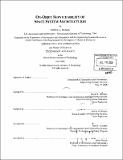On-orbit serviceability of space system architectures
Author(s)
Richards, Matthew G.
DownloadFull printable version (47.91Mb)
Other Contributors
Massachusetts Institute of Technology. Technology and Policy Program.
Advisor
Daniel E. Hastings and Donna H. Rhodes.
Terms of use
Metadata
Show full item recordAbstract
On-orbit servicing is the process of improving a space-based capability through a combination of in-orbit activities which may include inspection; rendezvous and docking; and value-added modifications to a satellite's position, orientation, and operational status. As a means to extend the useful life or operational flexibility of spacecraft, on-orbit servicing constitutes one pathway to a responsive space enterprise. Following launch, traditional satellite operations are tightly constrained by an inability to access the orbiting vehicle. With the exception of software upgrades from ground controllers, operators are wedded to supporting payload technologies that become rapidly obsolete and to bus structures that deform during the stress of launch and degrade in the harsh environment of space. On-orbit servicing offers satellite operators an option for maintaining or improving space-based capabilities without launching a new spacecraft. Numerous studies have been performed on on-orbit servicing, particularly regarding the architecture of the servicing provider. Several customer valuation case studies have also been performed to identify the economic case (or lack thereof) for different categories of servicing missions. (cont.) Little work, however, has been done to analyze the tradespace of potential on-orbit servicing customers-a global analysis of operational satellites currently orbiting the Earth. The goal of this research is to develop and test a methodology to assess the physical amenability of satellites currently in operation to on-orbit servicing. As defined here, physical amenability of a target satellite, or "serviceability," refers to the relative complexity required of a teleoperated or autonomously controlled robotic vehicle to accomplish on-orbit servicing. A three-step process is followed to perform serviceability assessments. First, a taxonomy of space systems is constructed to add structure to the problem and to identify satellite attributes that drive servicing mission complexity. Second, a methodology is proposed to assess serviceability across the four servicing activities of rendezvous, acquire, access, and service. (cont.) This includes development of an agent-based model based on orbital transfers as well as a generalized framework in which serviceability is decomposed into four elements: (1) knowledge, (2) scale, (3) precision, and (4) timing. Third, the value of architecture frameworks and systems engineering modeling languages for conducting serviceability assessments is explored through the development of a discrete event simulation of the Hubble Space Telescope. The thesis concludes with prescriptive technical considerations for designing serviceable satellites and a discussion of the political, legal, and financial challenges facing servicing providers.
Description
Thesis (S.M.)--Massachusetts Institute of Technology, Dept. of Aeronautics and Astronautics; and, (S.M.)--Massachusetts Institute of Technology, Engineering Systems Division, Technology and Policy Program, 2006. Includes bibliographical references (p. 171-182).
Date issued
2006Department
Massachusetts Institute of Technology. Department of Aeronautics and Astronautics; Massachusetts Institute of Technology. Engineering Systems Division; Technology and Policy ProgramPublisher
Massachusetts Institute of Technology
Keywords
Aeronautics and Astronautics., Technology and Policy Program.